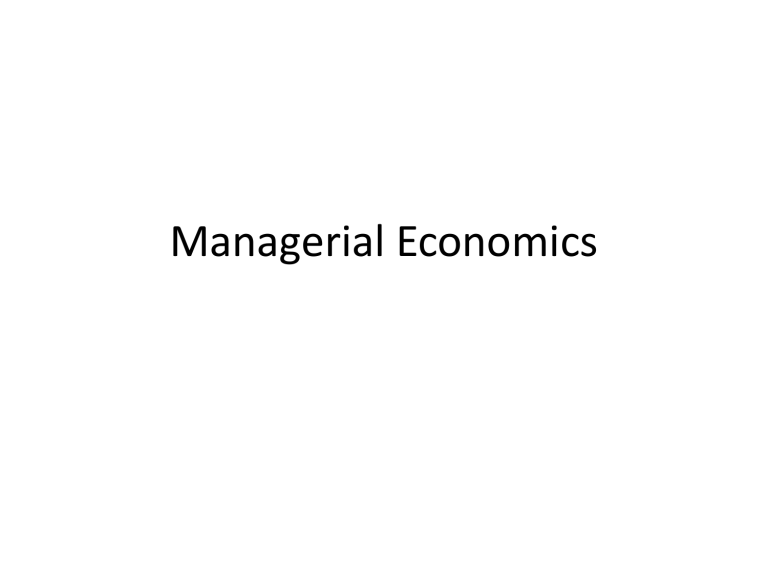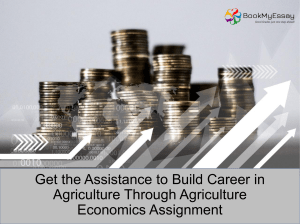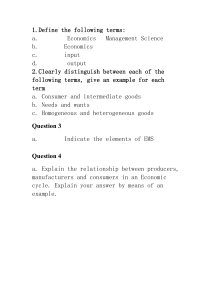
Managerial Economics Economics Defined The word economy comes from a Greek word Oikonomos which means “one who manages a household.” Economics deals with the allocation of scarce resources among alternative uses to satisfy human wants. Economics is the study of how society manages its scarce resources. Microeconomics and Macroeconomics • Microeconomics focuses on the individual parts of the economy. Branch of economics that deals with the behavior of individual economic units—consumers, firms, workers, and investors—as well as the markets that these units comprise. – How households and firms make decisions and how they interact in specific markets • Macroeconomics looks at the economy as a whole. It is the branch of economics that deals with aggregate economic variables like inflation, unemployment, and economic growth Ten Principles of Economics 4 THE THEMES OF MICROECONOMICS Trade-Offs Consumers Consumers have limited incomes, which can be spent on a wide variety of goods and services, or saved for the future. Workers Workers also face constraints and make trade-offs. First, people must decide whether and when to enter the workforce. Second, workers face trade-offs in their choice of employment. Finally, workers must sometimes decide how many hours per week they wish to work, thereby trading off labor for leisure. Firms Firms also face limits in terms of the kinds of products that they can produce, and the resources available to produce them. The Diverse Fields of Economics Examples of microeconomic and macroeconomic concerns Microeconomics Macroeconomics Production Prices Income Employment Production/Output in Individual Industries and Businesses Price of Individual Goods and Services Distribution of Income and Wealth How much steel How many offices How many cars Price of medical care Price of gasoline Food prices Apartment rents Wages in the auto industry Minimum wages Executive salaries Poverty Employment by Individual Businesses & Industries Jobs in the steel industry Number of employees in a firm National Production/Output Aggregate Price Level National Income Total wages and salaries Employment and Unemployment in the Economy Total Industrial Output Gross Domestic Product Growth of Output Consumer prices Producer Prices Rate of Inflation Total corporate profits Total number of jobs Unemployment rate 1.2 WHAT IS A MARKET? ● market Collection of buyers and sellers that, through their actual or potential interactions, determine the price of a product or set of products. ● market definition Determination of the buyers, sellers, and range of products that should be included in a particular market. ● arbitrage Practice of buying at a low price at one location and selling at a higher price in another. 1.2 WHAT IS A MARKET? Competitive versus Noncompetitive Markets ● perfectly competitive market Market with many buyers and sellers, so that no single buyer or seller has a significant impact on price. Market Price ● market price Price prevailing in a competitive market. 1.3 REAL VERSUS NOMINAL PRICES ● nominal price Absolute price of a good, unadjusted for inflation. For example the nominal price of butter was Taka 50 in 2005 and Taka 80 in 2015. ● real price: Price of a good relative to an aggregate measure of prices; price adjusted for inflation. Real price of butter in 2015 = (CPI 2005/CPI 2015)* Nominal price in 2015. ● Consumer Price Index Measure of the aggregate price level. ● Producer Price Index Measure of the aggregate price level for intermediate products and wholesale goods. POSITIVE VERSUS are NORMATIVE ANALYSIS • Positive statements statements that attempt to describe the world as it is. Positive economics studies economic behavior without making judgments. It describes what exists and how it works. – Called descriptive analysis • Normative statements are statements about how the world should be. Normative economics, also called policy economics, analyzes outcomes of economic behavior, evaluates them as good or bad, and may prescribe courses of action. – Called prescriptive analysis POSITIVE VERSUS NORMATIVE ANALYSIS • Positive or Normative Statements? ? – An increase in the minimum wage will cause a decrease in employment among the least-skilled. POSITIVE ? – Higher federal budget deficits will cause interest rates to increase. POSITIVE ? Fundamental Economic Problem • There are three fundamental economic problems for every human society. It is immaterial whether it is centrally planned, mixed or advanced industrial society. • They are what commodities are produced, how these goods are made and for whom they are produced. • What: Which goods and services a society chooses to produce and in what quantities. • How: how goods are produced; choice of technologies; division of labor who will do what. • For whom: for whom are goods produced? Distribution of products among household; what pattern it takes; where the income goes. Individual’s Economizing Problem • • • • Limited Income Unlimited Wants A Budget Line Attainable and Unattainable Combinations • Tradeoffs & Opportunity Costs • Choice • Income Change Individual’s Economizing Problem DVDs Books $20 $10 6 5 4 3 2 1 0 0 2 4 6 8 10 12 12 10 Quantity of DVDs $120 Budget Income = $120 =6 Pdvd = $20 8 Unattainable 6 Income = $120 = 12 Pb = $10 4 2 0 Attainable 2 4 6 8 10 Quantity of Books 12 14 Economic System • Market, Command and Mixed System – We have indicated three fundamental problems in the previous section. One can solve those problems in different way. It is a question of organization that what, how and for whom can be dealt with. The three available systems try to address those problems under their respective market system. – A market economy is one in which individuals private firms market the major decisions about production and consumption. A system of prices, market, of profits and losses, of incentives and rewards determines what, how and for whom. In extreme case the economy is seen practicing laissez-faire which means non-interference from the government side in economic decision making. What is Managerial Economics Douglas - “Managerial economics is .. the application of economic principles and methodologies to the decisionmaking process within the firm or organization.” Pappas & Hirschey - “Managerial economics applies economic theory and methods to business and administrative decision-making.” Salvatore - “Managerial economics refers to the application of economic theory and the tools of analysis of decision science to examine how an organisation can achieve its objectives most effectively.” INTRODUCTION OF MANAGERIAL ECONOMICS Concept of Managerial Economics (contd.) Following diagram shows how does the managerial economics provide the link between traditional economics and decision sciences Management Problems Economic Theory Decision Sciences Managerial Economics Economic Methodology: Descriptive Model Prescriptive Model Study of Functional Areas: Accounting, Finance, and Marketing Optimal Decision 17 Managerial Decision Problems Economic theory Microeconomics Macroeconomics Decision Sciences Mathematical Economics Econometrics MANAGERIAL ECONOMICS Application of economic theory and decision science tools to solve managerial decision problems OPTIMAL SOLUTIONS TO MANAGERIAL DECISION PROBLEMS What is Managerial Economics (contd.) It is an application of that part of microeconomics that focuses on Risk Demand Production Cost Pricing, and Market Structure. It helps rational decision making through MODEL BUILDING Stories of Four Great Economists Adam Smith (1723 – 1790) was a Scottish Economist. He is said FATHER OF ECONOMICS He is also FATHER OF CAPITALISM His Book: WEALTH OF NATIONS We want to talk about POVERTY not wealth. His main theory is “There is an invisible hand that determine everything – Don’t disturb it” What is the invisible hand? • Invisible hands – demand and supply – determines quantity and price P S D Q Economics is very easy • Teach a Parrot to say Demand and Supply – then the parrot becomes an economist. • Ask her any questions – she will say ‘demand and supply’ – then she is a great economist. David Ricardo • David Ricardo 1772-1823 • His theory said, increase in agricultural production would ultimately decline. Thomas Malthus • Thomas Robert Malthus, (1766-1834), English economist and demographer. Malthus • He was a Church Priest. • Once he noted he had never seen a dead bird. (except bats and crows). • He searched the reasons. • Bird die on a flowing stream and the body is taken away by the water. • Birds commit suicide when food is not available. – A tragic case – God cannot do this. • He investigated further and studied economics – especially Ricardo Population Theory His theory: population growth will always tend to outrun the food supply, * There will be hunger, famine, war, disasters, * Population Control is needed. * This is called Malthusianism Karl Marx Karl Heinrich Marx (1818 – 1883) was a German philosopher, economist, sociologist, historian, journalist and revolutionary socialist. His ideas played a significant role in establishing communism. He published various books. Das Kapital (1867–1894); His thinking, Factors of Production Congealed Labor theory Exploitation Dialectic Materialism John m Keynes 1883 – 21 April 1946 – A British Economist. Studied Mathematics Very young professor, most learned young man, Wanted to marry an illiterate women, Then what happened?? -- Wrote a book “General Theory” Could not sell. Lord Keynes (continued) • • • • • • • • Went to stock market, Dominated stock market, Became rich, Became Lord, Married, Divided economics into Macro and Micro, An interview of his wife. He successfully introduced mathematics in economics 1.1 THE THEMES OF MICROECONOMICS Theories and Models In economics, explanation and prediction are based on theories. Theories are developed to explain observed phenomena in terms of a set of basic rules and assumptions. A model is a mathematical representation, based on economic theory, of a firm, a market, or some other entity. The Process of Model-building • The economics ‘method’ • The steps: the hypothetical-deductive approach – make assumptions about behaviour – work out the consequences of those assumptions – make predictions – test the predictions against the evidence – PREDICTIONS SUPPORTED? The model is accepted as a good explanation (for the moment) – PREDICTIONS REFUTED? Go back and re-work the whole process Definitions & assumptions Theoretical analysis If predictions not supported by data, model is amended or discarded Predictions Predictions tested against data If predictions borne out by data, the model is valid, for the moment 32 Economic Laws Idea • Check the Idea • Prove it. If proved then Hypothesis • Prove the Hypothesis • If Proved then Theory Law • Prove the theory • If proved then • Law is valid every where, Economic Policy Criteria for judging economic outcomes: • Efficiency, or allocative efficiency. An efficient economy is one that produces what people want at the least possible cost. • Equity, or fairness of economic outcomes. • Growth, or an increase in the total output of an economy. • Stability, or the condition in which output is steady or growing, with low inflation and full employment of resources. Figure 1 The Circular Flow MARKETS FOR GOODS AND SERVICES •Firms sell Goods •Households buy and services sold Revenue Wages, rent, and profit Goods and services bought HOUSEHOLDS •Buy and consume goods and services •Own and sell factors of production FIRMS •Produce and sell goods and services •Hire and use factors of production Factors of production Spending MARKETS FOR FACTORS OF PRODUCTION •Households sell •Firms buy Labor, land, and capital Income = Flow of inputs and outputs = Flow of Taka Copyright © 2004 South-Western Assumptions Assumption: The economy composed of households and firms only Households: own factors of production, consume goods and service Firms: hire factors of production to produce goods and services The Production Possibilities FrontierModel: The Production Possibilities Frontier The production possibilities frontier is a graph that shows the combinations of output that the economy can possibly produce given the available factors of production and the available production technology. Figure 2 The Production Possibilities Frontier Quantity of Garments Produced 3,000 D C 2,200 2,000 A Production possibilities frontier B 1,000 0 300 600 700 1,000 Quantity of Rice Produced Figure 3 The Production Possibilities Frontier Quantity of Garments Produced 3,000 D C 2,200 2,000 A Production possibilities frontier B 1,000 0 300 600 700 1,000 Quantity of Rice Produced The Margin: The Key Unifying Concept in Microeconomics Marginal Benefit & Marginal Cost Marginal Analysis 15 a c MC MB = MC e 10 5 b d MB 0 1 2 3 Quantity of Pizza Value of the Firm The present value of all expected future profits Economic Cost of Resources • Opportunity cost of using any resource is: – What firm owners must give up to use the resource • Market-supplied resources – Owned by others & hired, rented, or leased • Owner-supplied resources – Owned & used by the firm 1-43 Total Economic Cost • Total Economic Cost – Sum of opportunity costs of both market-supplied resources & owner-supplied resources • Explicit Costs – Monetary payments to owners of market-supplied resources • Implicit Costs – Nonmonetary opportunity costs of using ownersupplied resources 1-44 Economic Cost of Using Resources (Figure 1.1) E x p lic itC o s t s o f M a r k e t S u p p lie d R e s o u r c e s T h e m o n e ta r y p a y m e n ts to r e s o u r c e o w n e r s + Im p lic itC o s t s o f O w n e r S u p p lie d R e s o u r c e s T h e r e tu r n s fo r g o n e b y n o tta k in g th e o w n e r s ’r e s o u r c e s to m a r k e t = T o t a lE c o n o m ic C o s t T h e to ta lo p p o r tu n ity c o s ts o f b o th k in d s o fr e s o u r c e s Economic Profit versus Accounting Profit • Economic profit = Total revenue – Total economic cost = Total revenue – Explicit costs – Implicit costs • Accounting profit = Total revenue – Explicit costs • Accounting profit does not subtract implicit costs from total revenue • Firm owners must cover all costs of all resources used by the firm – Objective is to maximize economic profit 1-46




